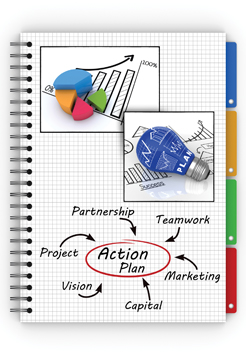
Marketing Your Service Business: A Guide for Small Business Owners—Chapter Eight:
The Marketing Plan, Part II
By Beth Borrego / Published February 2014

Editor’s Note: This is Part II of a chapter on establishing a company marketing plan. Part I appeared in the December 2013 issue of Cleaner Times | IWA.
If you recall from Part I, a discussion began concerning the framework of a very important document that’s crucial to the success of any small service business; the marketing plan. Marketing is a not a single action, but many components used in a synchronized effort to identify, attract, and maintain profitable business relationships with customers. These steps include everything from demographic research, to advertising, image building, bundling and pricing, and sales and customer service.
A well-written marketing plan will illustrate how your company plans to position itself in the market, so that consumers can clearly see that they have a need to purchase your services. If your services or products are positioned properly, potential customers should identify the unique benefits being offered, and as you begin to develop brand recognition, your sales and market share will increase. Each of the bolded sections in this chapter represents a portion of the marketing plan you are preparing to write. At the end of this chapter is a sample of a marketing plan outline to use as a framework to create one of your own.
Distribution
Identify the best and most effective methods for delivering services to the customers in the market you are serving. Be sure to consider factors such as the hours your technicians’ work, the number of technicians per crew, and the equipment they’ll need to perform service calls. Make sure to plan for things like truck lettering, employee uniforms, and customer service training as well, because they are all a very important part of your company image.
If you are selling a product, identify the need for warehousing and distributing these products. Selecting a brick-and-mortar location is one of the most important decisions you will ever make if you are warehousing or distributing products. Will there be walk-in traffic, or will the location only be used to pick, pack, and ship? Planning for growth and making sure you have the right location and amount of space is important, because you don’t want to be out of space the day you move in, but neither do you want to have a large amount of unused space that you are paying rent on. Consider stocking levels and demand carefully, and plan for expected annual growth when deciding how much space is enough.
Promotional Mix
In this section, you’ll describe your company’s compartmentalized advertising program, which may contain an ad agency or print media source, which media sources will be used, how often the ad copy will run, which audiences will be targeted, how many consumers or households each will reach, the estimated response rates, and how much each of these campaigns will cost. This is done for each market you serve. Each one of your targeted advertising programs should have a budget, and the costs for each one should be outlined and totaled to give you an overall advertising budget number. List the campaigns you plan to use for each service segment and assign a budget to it. Consider the items listed below:
• Company website
• Direct mail (postcards, coupon inserts, and focused advertising magazines)
• Trade association networking
• E-mail
• Social media
• Radio or television
• Billboards
• Newspaper or phonebook ads
• Home shows or fairs
Public Relations
As you can see, a compartmentalized advertising program is very specifically defined and specifies all of the advertising and promotional activity for a specific service segment.
Identify the specific opportunities for public relations events. List the benefits to the community, as well as those for your company. Be sure to include the costs associated with these events and factor them into your budget. Be sure to list the methods you will use to promote the events, both during the event and afterward as ongoing PR for the company. Some of the methods used to promote a public relations event may include notifying the press, submitting press releases, adding a page to your company website, or sending out a mailing to your existing client base announcing the event and how they can participate or contribute to it. Consumer contributions might be as simple as your business collecting gently used coats for children in need in the fall, or a food drive supporting a local food bank.
Sales Forecasting
In order to sell successfully, you need to understand your competition. Arming yourself with as much information about both direct and indirect competition as possible will help you to position your company in the marketplace, thereby increasing the likelihood of success.

When possible, review the competitions’ sales history through secondary research. This will be harder to do with smaller companies, but it’s not impossible, and a ballpark estimate should provide you with a basic benchmark. Review recent sales trends in the industry for your company’s service area. Has there been growth, or has the market been soft?
All businesses have an annual cycle indicating their busy season and slower times. Identify the seasonal peaks and valleys your business faces annually, and plan for them. Plan your advertising, staffing, and service promotions according to the cycle. Then, project the sales and income for the next four quarters. To accomplish this, refer to your business plans’ cash flow estimates.
Develop a sales pipeline, listing all prospects and leads as well as their potential dollar values. This pipeline should continue to grow, and over time, you should be able to determine the percentage of each service or product type that converts from a lead to a sale. A properly developed pipeline also makes forecasting much, much easier.
Action Plan
The action plan should fully list all marketing strategies and related activities. Make sure to prioritize all of the strategies in order of importance, in case you need to make changes later on. Higher priority items should be the ones that are the best income-generating sources for your company.
Production Rates
Determine the levels of production required to meet the demand generated for the services and products offered by marketing efforts you have implemented or plan to implement. Production rates are tied to profit.
For example, if productivity declines, the number of service calls completed may decline, yet you are still paying your employee the same wage for the number of hours worked that day. In that scenario, your profit will have decreased because the employee was less productive. Knowing what the reasonable and expected rates for productivity is, and then training all personnel to work at those rates is an important part of remaining profitable.
Below is the outline for your own marketing plan. Following this outline should make it easier to put the flesh on the bones so to speak.
Sample Marketing Plan Outline
• Mission Statement
• State the purpose of the marketing plan.
• List the business goals; explain why you are in business. Some businesses also list personal goals.
• Review both business goals and objectives as well as identified strategies for reaching them.
Services and Products
• Identify your services and products specifically, identifying them by name, bundle, or brand; distinguishing characteristics; or other traits.
• Describe the differences between your services and products in terms of exclusive processes or other features.
• Identify the weaknesses in your services and products.
• Describe service and product lines and any new services or products you plan to introduce.
• List the cost of each service or product.
• Estimate the percentage of annual sales and the dollar amount each service and product should produce.
• Provide the price you plan to charge for each service and product you offer for sale.
The Market
• Include all demographic and lifestyle information you have collected to identify your customers.
• Next, identify the geographic region or area of these customers.
• Identify the factors used by the customers’ selection of your services or products.
• Note the size of the total market.
• Pinpoint market trends, noting any identified factors that you believe will affect sales.
• Define the factors that impact sales such as seasonal ability to perform services, decline in service popularity, pricing or availability, emotional purchases, and so forth.
• Describe any promotional efforts that will take place in specific markets and for which specific segments.
Direct and Indirect Competition
• Identify both direct and indirect competitors by services, products, and markets.
• Compare your company’s and your competition’s strengths and weaknesses.
• Compare your marketing techniques with those of your competitors.
Pricing
• Verify all fixed and variable expenses related to services and products to ensure accuracy.
• Make sure all services and products are profitable.
• Compare your prices for products and services with others in the industry. Higher than average prices should be justified via added value, lower than average prices should be explained in your marketing strategy.
Distribution
• Identify the best and most effective methods for delivering services or products to the customers in the market you are serving.
• If you are selling a product, identify the need for warehousing and distributing these products.
Promotional Mix
• Describe a compartmentalized advertising program containing: all advertising and print media sources, specifying which will be used, which market audiences will be targeted, and how much each of these campaigns will cost.
• Identify opportunities for public relations events, and list the costs associated with them.
Sales Forecasting
• Review the competitions’ sales history through secondary research.
• Review recent sales trends in the industry.
• Make the necessary seasonal adjustments.
• Project the sales and income for the next four quarters. For this, refer to your business plan’s cash flow estimates.
Action Plan
• Fully list all marketing strategies and related activities.
• Prioritize all strategies in order of importance.
Production Rates
• Determine the levels of production required to meet the demand generated for the services and products offered by marketing efforts.
As we come to the end of this chapter, you should have a good understanding of the purpose of your company’s marketing plan, and you should be equipped enough to begin to write one of your own. Don’t skip this step. Take it one step at a time and follow the outline. Having a marketing plan in place will help to ensure the success of your business.




